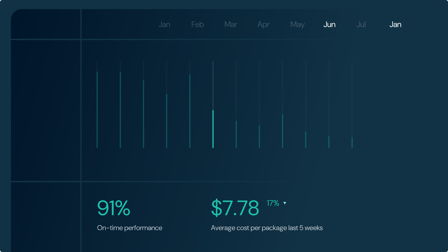Use Shipium’s Time-in-Transit Settings to Align Dates to Your Business Goals

Presenting the right delivery date can influence everything from conversion rates to customer satisfaction to operational costs. For many shippers, the challenge is finding the right balance. How do you select a date that’s both accurate and aligned with your business goals? Is it better to promise a faster date to win a sale, or a more conservative one to guarantee on-time delivery?
Shipium's Time-in-Transit (TNT) settings solve this problem by giving you a range of options and enabling you to choose an estimate that directly serves your business priority — whether that's maximizing conversion, ensuring reliability, or (likely) something in between.
Understanding time-in-transit settings in Shipium
Shipium's TNT modeling doesn't just produce a single delivery date; it generates a range of possible outcomes for each shipment (ex. fastest possible, most likely, longest likely). The TNT setting a shipper chooses acts as a filter, with each setting corresponding to one of the produced dates. The configured setting dictates which date is ultimately used:
- Aggressive: Chooses an estimate closer to the fastest possible delivery time.
- Conservative: Selects an estimate closer to the longest likely delivery time.
- Standard: Provides a balanced estimate between the two.
Based on this, shippers select the setting that best corresponds to their goals — more on this below.
Aligning settings with business priorities
There’s no single “right” setting when it comes to Shipium’s TNT predictions; instead, your choice of TNT setting should be directly linked to your business priorities.
- Aggressive → Conversion: Use this setting if you’re prioritizing conversion and differentiating yourself based on delivery speed. Presenting the fastest possible delivery times can help to create a more competitive shopping experience and increase the chances that customers will convert. However, the tradeoff is a higher risk of late deliveries, which you must be willing to accept when pursuing this approach.
- Conservative or Very Conservative → Reliability: Choose these settings to prioritize on-time delivery. This is ideal for companies that want to minimize the risk of late shipments. While this may mean showing slightly longer transit times to customers and potentially missing out on some cost-saving downgrade opportunities, it provides a stronger guarantee of meeting the promised date.
- Standard → Balance: This is the most balanced approach for companies seeking a mix of delivery reliability, speed, and cost-effectiveness.
A note on Exact Date Delivery (ExDD)
The TNT model's ability to predict a range of delivery dates is also crucial for Shipium's Exact Date Delivery (ExDD) modeling. By predicting a full range of outcomes, the model also provides some measure of confidence for its predictions. When the predicted window is very narrow (ex. the fastest, most likely, and longest times are all within a day of each other), the model has a high degree of confidence in the delivery date.
In these high-confidence scenarios, Shipium can enable a more precise delivery promise to further improve the customer experience.
How transit time values are prioritized
Now that we’ve covered Shipium’s range of transit time settings, it’s worth noting the role these play in the broader process of delivery date presentation.
TNT values are integrated into a hierarchy that ensures a delivery estimate is always available. The Shipium Calculated value is powered by the TNT model and its settings. Customer Overrides are values configured and provided directly by you, the shipper. Lastly, Carrier Defaults are pulled from carrier-provided transit tables.
Shipium’s customers determine the hierarchy they’d like to use, then Shipium automatically executes based on that hierarchy. For example, if your desired approach is to prioritize your own Customer Overrides for certain lanes, use Shipium Calculated values for the rest, and use Carrier Defaults as a fallback, the process would look like this:
- Customer Overrides: The system first checks for a value provided by you. If one is available, it is used.
- Shipium Calculated: If no Customer Override exists, Shipium will use the estimate provided by our TNT modeling, which is based on the shipper's chosen setting.
- Carrier Defaults: As a final fallback, if a Shipium value cannot be generated for whatever reason, the system defaults to the carrier's provided estimate.
This hierarchy ensures flexibility while prioritizing your desired transit values whenever possible.
Wrapping up
By leveraging Shipium’s ML modeling, which predicts a range of potential delivery dates with varying degrees of aggressiveness, you can align the shopping experience with operational priorities.
Whether you choose an aggressive setting to drive conversion, a conservative one to ensure reliability, or a standard approach for a balanced mix, you gain more control over common tradeoffs between speed, cost, and accuracy. As business priorities change over time, you also have the flexibility to adapt your approach without requiring a major process overhaul.
If taking a more nuanced approach to delivery date presentation is a priority, reach out to our team here to see if Shipium can help.



